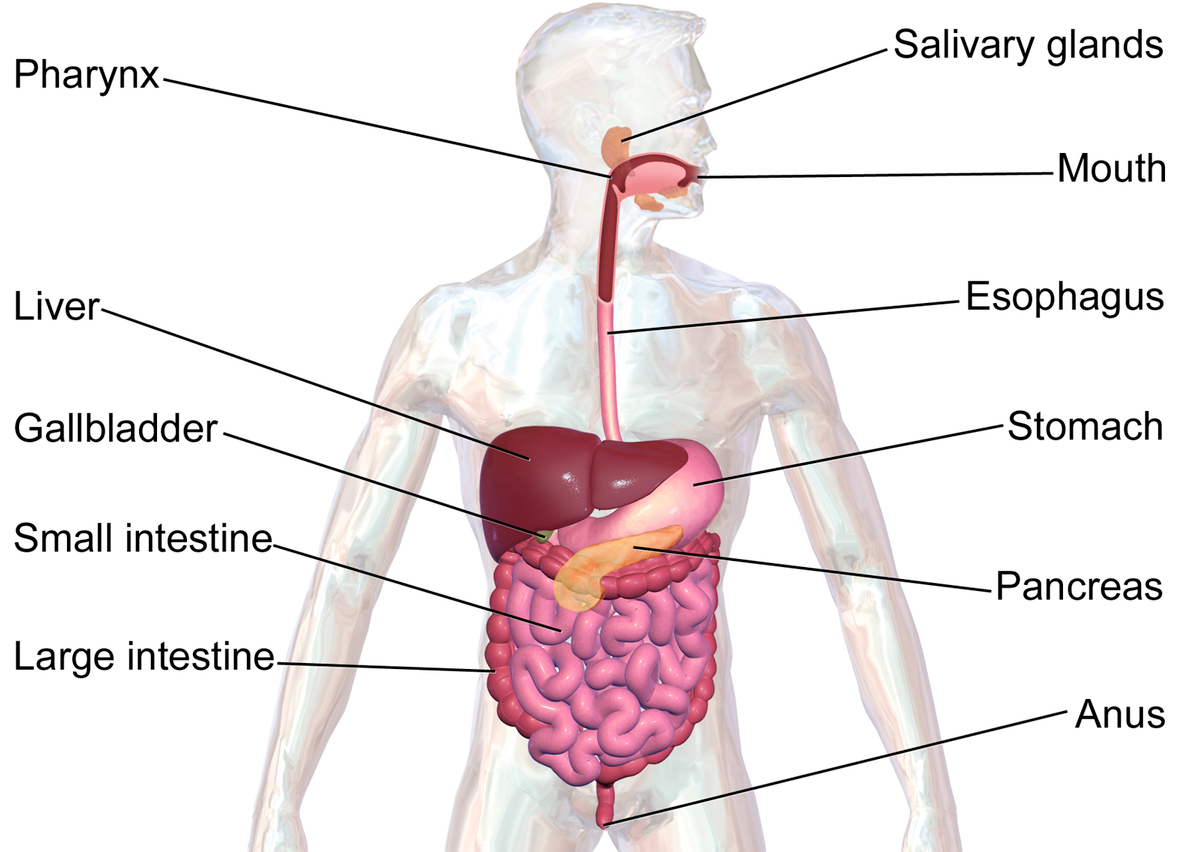
Make a neat and labelled diagram of the alimentary canal of man and explain the physiology of protein and fat digestion.
Answer
560.7k+ views
Hint: The entire process of digestion starts with chewing or mastication of food in our mouths. As we break down the foodstuffs into smaller and smaller particles, various enzymes are released, which act on carbohydrates and fats. The salivary amylase and lipase.
Complete Answer:
- The human GI tract or alimentary canal begins at the mouth and ends at the anus. From the mouth, food enters the oesophagus from where it is taken into the stomach. The pyloric sphincter controls the release of the gastric contents into the duodenum and small intestine, and then into the colon or large intestine, ending at the rectum. Waste products are then excreted through the anus.
- Along with the alimentary canal are associated the pancreas, liver, salivary glands, and gallbladder which produce the required digestive enzymes.
- Proteins are polymers of amino acids. They may be monomeric or multimeric. For them to be absorbed, they need to be broken down into free amino acids and some di- and tripeptides. Protein digestion does not begin in the mouth, but in the stomach.
- Gastric juices which are at a very low pH as well as hydrolytic enzymes which include endo and exopeptidases break down the proteins into smaller chains and free amino acids. Pepsin is the main endopeptidase in the stomach which breaks protein chains into proteoses and peptones.
- In the intestines, pepsin is inactivated and pancreatic enzymes like trypsin, elastase, and carboxypeptidases take over. The di and tripeptides are absorbed by cells of the intestinal lumen, further hydrolysed to free amino acids, and these then enter circulation.
- Fat digestion begins with emulsifying them so that there is a greater surface area for the lipases to act on. A small amount of digestion begins in the mouth, but most digestion of fat is in the intestines.
- Digestion in the stomach is about emulsification, in the intestines, bile acids solubilise lipids in the form of micelles, and enzymes like pancreatic lipase and phospholipase A2 release free fatty acids, monoglycerides and cholesterol from the triglycerides.
- Being fat soluble, these digestion products easily cross the cell walls of the lining epithelium. Lipid digestion products then reform triglycerides, combine with Apo proteins to form chylomicrons, and are released into the bloodstream.

Note: Carbohydrate digestion begins with salivary amylase in the mouth, and is completed in the intestine. Digestion has to result in production of monosaccharides, as only these carbohydrate digestion products are absorbed.
Complete Answer:
- The human GI tract or alimentary canal begins at the mouth and ends at the anus. From the mouth, food enters the oesophagus from where it is taken into the stomach. The pyloric sphincter controls the release of the gastric contents into the duodenum and small intestine, and then into the colon or large intestine, ending at the rectum. Waste products are then excreted through the anus.
- Along with the alimentary canal are associated the pancreas, liver, salivary glands, and gallbladder which produce the required digestive enzymes.
- Proteins are polymers of amino acids. They may be monomeric or multimeric. For them to be absorbed, they need to be broken down into free amino acids and some di- and tripeptides. Protein digestion does not begin in the mouth, but in the stomach.
- Gastric juices which are at a very low pH as well as hydrolytic enzymes which include endo and exopeptidases break down the proteins into smaller chains and free amino acids. Pepsin is the main endopeptidase in the stomach which breaks protein chains into proteoses and peptones.
- In the intestines, pepsin is inactivated and pancreatic enzymes like trypsin, elastase, and carboxypeptidases take over. The di and tripeptides are absorbed by cells of the intestinal lumen, further hydrolysed to free amino acids, and these then enter circulation.
- Fat digestion begins with emulsifying them so that there is a greater surface area for the lipases to act on. A small amount of digestion begins in the mouth, but most digestion of fat is in the intestines.
- Digestion in the stomach is about emulsification, in the intestines, bile acids solubilise lipids in the form of micelles, and enzymes like pancreatic lipase and phospholipase A2 release free fatty acids, monoglycerides and cholesterol from the triglycerides.
- Being fat soluble, these digestion products easily cross the cell walls of the lining epithelium. Lipid digestion products then reform triglycerides, combine with Apo proteins to form chylomicrons, and are released into the bloodstream.

Note: Carbohydrate digestion begins with salivary amylase in the mouth, and is completed in the intestine. Digestion has to result in production of monosaccharides, as only these carbohydrate digestion products are absorbed.
Recently Updated Pages
Master Class 10 General Knowledge: Engaging Questions & Answers for Success

Master Class 10 Science: Engaging Questions & Answers for Success

Master Class 10 Social Science: Engaging Questions & Answers for Success

Master Class 10 Maths: Engaging Questions & Answers for Success

Master Class 10 English: Engaging Questions & Answers for Success

Master Class 10 Computer Science: Engaging Questions & Answers for Success

Trending doubts
The shortest day of the year in India

Why is there a time difference of about 5 hours between class 10 social science CBSE

Write a letter to the principal requesting him to grant class 10 english CBSE

What is the median of the first 10 natural numbers class 10 maths CBSE

The Equation xxx + 2 is Satisfied when x is Equal to Class 10 Maths

State and prove converse of BPT Basic Proportionality class 10 maths CBSE




